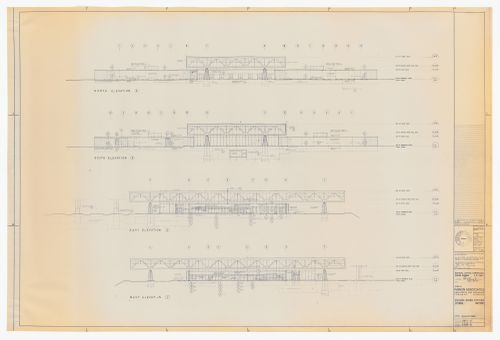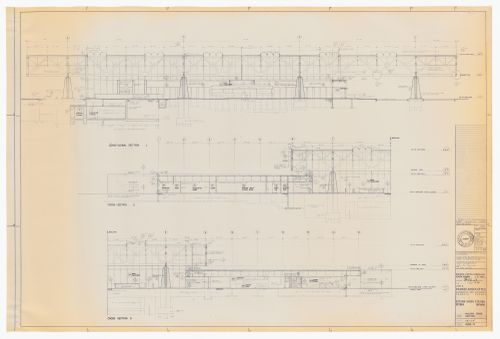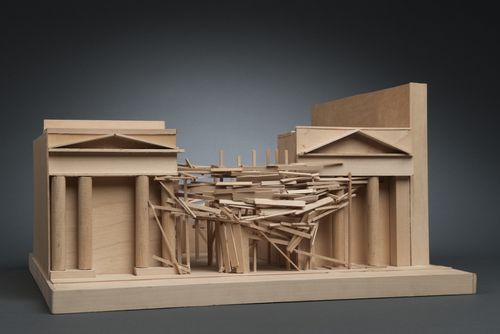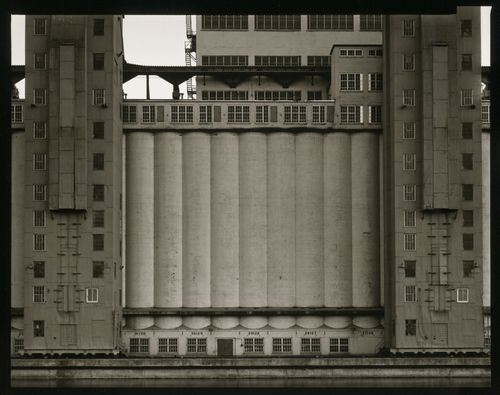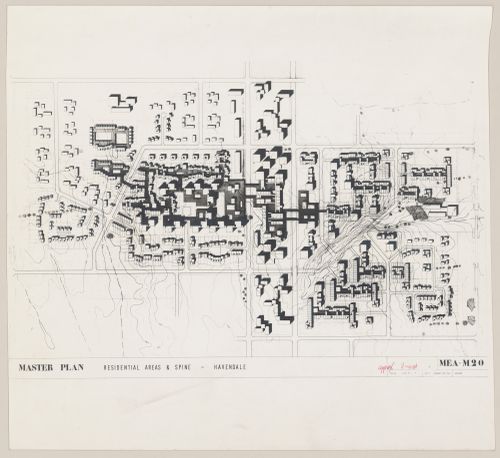Project
AP056.S1.2000.PR01
Description:
This project series documents additions and alterations to St. Andrew's College in Aurora, Ontario from 2000-2003. The office identified the project number as 2000-21. This project, headed by Marianne McKenna, consisted of the addition of a middle school wing onto an existing building, a parking lot and outdoor spaces and alterations to the existing college, originally constructed in 1926. These changes to the private boy's school were in response to a task force that identified deficiencies in the campus for a curriculum of the 21st century. While a new gymnasium was added to the middle school, the old gym in Dunlap Hall was converted into a three-storey art facility. The existing Ketchum Auditorium was also restored and renovated for the drama program.[1] The master plan study predating this project was completed under a different project number (see project series AP056.S1.1999.PR02 described in this fonds). This project is recorded through drawings dating from 1999-2001. The drawings are mostly originals and consist of sketches, presentation drawings, plans, elevations, sections, details and axonometric drawings. [1]"St. Andrew's College" KPMB. Accessed August 1, 2019. http://www.kpmb.com/project/st-andrews-college/
1999-2001
St. Andrew's College, Aurora, Ontario (2000-2003)
Actions:
AP056.S1.2000.PR01
Description:
This project series documents additions and alterations to St. Andrew's College in Aurora, Ontario from 2000-2003. The office identified the project number as 2000-21. This project, headed by Marianne McKenna, consisted of the addition of a middle school wing onto an existing building, a parking lot and outdoor spaces and alterations to the existing college, originally constructed in 1926. These changes to the private boy's school were in response to a task force that identified deficiencies in the campus for a curriculum of the 21st century. While a new gymnasium was added to the middle school, the old gym in Dunlap Hall was converted into a three-storey art facility. The existing Ketchum Auditorium was also restored and renovated for the drama program.[1] The master plan study predating this project was completed under a different project number (see project series AP056.S1.1999.PR02 described in this fonds). This project is recorded through drawings dating from 1999-2001. The drawings are mostly originals and consist of sketches, presentation drawings, plans, elevations, sections, details and axonometric drawings. [1]"St. Andrew's College" KPMB. Accessed August 1, 2019. http://www.kpmb.com/project/st-andrews-college/
Project
1999-2001
Project
AP018.S1.1966.PR01
Description:
This project series documents the construction of the Etobicoke General Hospital in Etobicoke, Ontario from 1966-1971. The office identified the project number as 6601. The project consisted of the design and construction of a twelve storey hospital building. The area of the building was 409,000 square feet and included 500 beds, diagnostic and treatment facilities, laboratories, administrative spaces, a cafeteria, and a staff lounge. This project was considered to be the first phase of construction at the time, with a medical office building and educational facilities to be added later on. The building was also designed to accommodate future vertical and horizontal expansion. John C. Parkin was originally hired for this project while he was working at the firm John B. Parkin Associates. This firm eventually evolved under new ownership, and was referred to as Searle Wilbee Rowland and later, as NORR. John C. Parkin left this firm during the project and continued work for the Etobicoke General Hospital under his new firm Parkin Architects Planners. All three firm names are present within materials for this project. The project is recorded through reprographic copies of drawings, including a presentation board, dating from 1968-1976. These drawings include as-built drawings, site plans, floor plans, elevations, sections, details, and construction schedules.
1968-1976
Etobicoke General Hospital, Etobicoke, Ontario (1966-1971)
Actions:
AP018.S1.1966.PR01
Description:
This project series documents the construction of the Etobicoke General Hospital in Etobicoke, Ontario from 1966-1971. The office identified the project number as 6601. The project consisted of the design and construction of a twelve storey hospital building. The area of the building was 409,000 square feet and included 500 beds, diagnostic and treatment facilities, laboratories, administrative spaces, a cafeteria, and a staff lounge. This project was considered to be the first phase of construction at the time, with a medical office building and educational facilities to be added later on. The building was also designed to accommodate future vertical and horizontal expansion. John C. Parkin was originally hired for this project while he was working at the firm John B. Parkin Associates. This firm eventually evolved under new ownership, and was referred to as Searle Wilbee Rowland and later, as NORR. John C. Parkin left this firm during the project and continued work for the Etobicoke General Hospital under his new firm Parkin Architects Planners. All three firm names are present within materials for this project. The project is recorded through reprographic copies of drawings, including a presentation board, dating from 1968-1976. These drawings include as-built drawings, site plans, floor plans, elevations, sections, details, and construction schedules.
Project
1968-1976
Project
AP056.S1.1995.PR02
Description:
This project series documents the Providence Healthcare Centre in Scarborough, Ontario from 1995-2000. The office identified the project number as 9504. This project, headed by Marianne McKenna in joint-venture with Montgomery and Sisam Architects, consisted of a long-term care facility on the Healthcare Centre campus located at the corner of St. Clair East and Warden Avenues. The facility diverged from the traditional institutional model to house 288 residents in a more residential setting. Bay windows, porches and chimneys were borrowed from residential architecture to contribute to this effect. The "houses," accommodating 18 residents each, were four-storeys high and arranged in two L-shaped wings with landscaped gardens in their interior courtyards. A double-height Great Hall joined the two volumes at the building's centre, which was built to house a variety of social and recreational activities for the residents. A chapel, hair salon, café and general store were also included. The project was also known as the Cardinal Ambrozic Houses of Providence. The project is recorded through drawings and presentation watercolour paintings dating from 1995-1999. The drawings are mostly originals and include a large number of sketches along with presentation renderings, plans, elevations, sections, perspectives and details.
Providence Healthcare Centre, Scarborough, Ontario (1995-2000)
Actions:
AP056.S1.1995.PR02
Description:
This project series documents the Providence Healthcare Centre in Scarborough, Ontario from 1995-2000. The office identified the project number as 9504. This project, headed by Marianne McKenna in joint-venture with Montgomery and Sisam Architects, consisted of a long-term care facility on the Healthcare Centre campus located at the corner of St. Clair East and Warden Avenues. The facility diverged from the traditional institutional model to house 288 residents in a more residential setting. Bay windows, porches and chimneys were borrowed from residential architecture to contribute to this effect. The "houses," accommodating 18 residents each, were four-storeys high and arranged in two L-shaped wings with landscaped gardens in their interior courtyards. A double-height Great Hall joined the two volumes at the building's centre, which was built to house a variety of social and recreational activities for the residents. A chapel, hair salon, café and general store were also included. The project was also known as the Cardinal Ambrozic Houses of Providence. The project is recorded through drawings and presentation watercolour paintings dating from 1995-1999. The drawings are mostly originals and include a large number of sketches along with presentation renderings, plans, elevations, sections, perspectives and details.
Project
Project
AP056.S1.1993.PR01
Description:
This project series documents the Scarborough Community Complex in Scarborough, Ontario from 1993-1996. The office identified the project number as 9311. This project, headed by Bruce Kuwabara in joint-venture with Patrick T. Chan, consisted of a multi-building complex on the corner of Progress and Sheppard Avenues. The project was formerly known as the Chinese Community Centre, which was the prominent building on the site. The Complex's main entrance, located on the site's interior, was highlighted by the Festival Plaza and Festival Court, whose octagonal shape was a nod to the eight essential strokes of Chinese calligraphy. The Festival Court led both to the Chinese Community Centre and a building with a public library and multi-purpose spaces (commonly referred to in the drawings as the Scarborough Community Complex). The Chinese Community Centre had a Festival Hall at it's entrance with wood and custom light fixtures that referred to Chinese craft techniques. This project also planned for vast Chinese gardens around the buildings, a large theatre building and a school at the south-end of the site. The project is recorded through drawings and a magazine publication on the finished project dating from 1992-1996. The drawings are mostly originals and include sketches, presentation drawings, plans, elevations, sections, perspectives and construction drawings. At least eleven schemes were investigated through these drawings.
1992-1996
Scarborough Community Complex, Scarborough, Ontario (1993-1996)
Actions:
AP056.S1.1993.PR01
Description:
This project series documents the Scarborough Community Complex in Scarborough, Ontario from 1993-1996. The office identified the project number as 9311. This project, headed by Bruce Kuwabara in joint-venture with Patrick T. Chan, consisted of a multi-building complex on the corner of Progress and Sheppard Avenues. The project was formerly known as the Chinese Community Centre, which was the prominent building on the site. The Complex's main entrance, located on the site's interior, was highlighted by the Festival Plaza and Festival Court, whose octagonal shape was a nod to the eight essential strokes of Chinese calligraphy. The Festival Court led both to the Chinese Community Centre and a building with a public library and multi-purpose spaces (commonly referred to in the drawings as the Scarborough Community Complex). The Chinese Community Centre had a Festival Hall at it's entrance with wood and custom light fixtures that referred to Chinese craft techniques. This project also planned for vast Chinese gardens around the buildings, a large theatre building and a school at the south-end of the site. The project is recorded through drawings and a magazine publication on the finished project dating from 1992-1996. The drawings are mostly originals and include sketches, presentation drawings, plans, elevations, sections, perspectives and construction drawings. At least eleven schemes were investigated through these drawings.
Project
1992-1996
Project
AP056.S1.1987.PR01
Description:
This project series documents the design and construction of the Di Stefano residence located at 98 Tetherwood Boulevard in London, Ontario from 1987-1990. The office identified the project number as 8720. This project consisted of a V shaped house with a red brick masonry veneer and cedar shingles that was about 3300 square feet in size. From above, the two arms of the V appeared almost as separate structures, connected only at the front of the home by an entrance hall. However, the front facade of the home joined the two arms fluidly using a curved wall that matched the round street court in front of the home. One arm of the house was two storeys with a garage and kitchen on the ground floor and bedrooms on the second. This arm was shorter than the other but opened onto a patio in the backyard. The other arm contained the master bedroom and great hall on the ground floor and in place of a second storey, had a sloped roof with four chimneys. There was also a basement for storage, with future plans for a rec room and workshop. Several design schemes were investigated for this home, with variations on the floor plan layout, the shape of the house, the number of storeys, and the positioning of the garage and patio. The project is recorded through original drawings used for design and construction which date from 1987-1990. The large part of the drawings consist of sketches, plans, elevations, sections, details, isometrics and perspectives.
1987-1992
Di Stefano Residence, London, Ontario (1987-1990)
Actions:
AP056.S1.1987.PR01
Description:
This project series documents the design and construction of the Di Stefano residence located at 98 Tetherwood Boulevard in London, Ontario from 1987-1990. The office identified the project number as 8720. This project consisted of a V shaped house with a red brick masonry veneer and cedar shingles that was about 3300 square feet in size. From above, the two arms of the V appeared almost as separate structures, connected only at the front of the home by an entrance hall. However, the front facade of the home joined the two arms fluidly using a curved wall that matched the round street court in front of the home. One arm of the house was two storeys with a garage and kitchen on the ground floor and bedrooms on the second. This arm was shorter than the other but opened onto a patio in the backyard. The other arm contained the master bedroom and great hall on the ground floor and in place of a second storey, had a sloped roof with four chimneys. There was also a basement for storage, with future plans for a rec room and workshop. Several design schemes were investigated for this home, with variations on the floor plan layout, the shape of the house, the number of storeys, and the positioning of the garage and patio. The project is recorded through original drawings used for design and construction which date from 1987-1990. The large part of the drawings consist of sketches, plans, elevations, sections, details, isometrics and perspectives.
Project
1987-1992
ARCH285772
Description:
Drawing number 6253-8
1965
Elevations for Ottawa Union Station, Ottawa, Ontario
Actions:
ARCH285772
Description:
Drawing number 6253-8
ARCH285773
Description:
Drawing number 6253-9
1965
Sections for Ottawa Union Station, Ottawa, Ontario
Actions:
ARCH285773
Description:
Drawing number 6253-9
DR2002:0001
installation
1989
installation
PH1985:0186
1977
ARCH400713
circa 1960-1962
